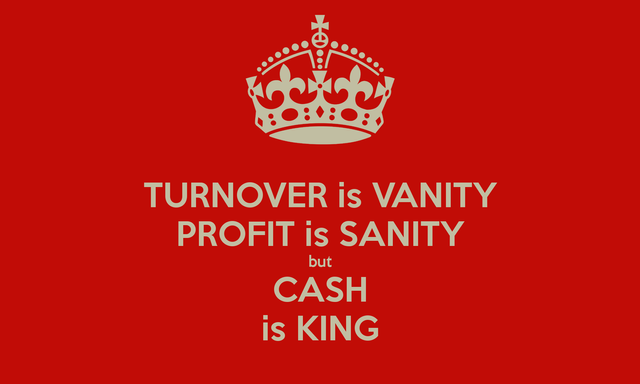How to keep a reasonable free cash flow in a company?

Many people believe that the indicators of efficiency of activity of the company is its profitability. However, many expenses and revenues that are recorded in the balance sheet that is not tied to real money. We are talking about depreciation allowances and exchange rate revaluations of assets. Also part of the profits goes into capital expenditures and current operations. Real understanding about the amount of money earned gives free cash flow. Place of free cash flow, among other financial indicators. Free cash flows the activity of the enterprise there are several types of cash flows. Total (gross) amount of money fixed in indicator NCF (net cash flow), which is based on the summation of all positive and negative financial transactions from investment, financial and operating activities of the company. However, much more expressive is another indicator. Free cash flow (FCF – free cash flow) is the amount of money which remains available to owners and investors after deducting all taxes as well as capital investments. In fact, it is cash that increase shareholder value and broaden the base of its assets. If FCF has a good positive indicator, the company can develop and produce new products, to pay increased dividends, buy assets, therefore, becomes more attractive to its shareholders.
The free flow of the company (FCFF) is the cash after subtracting capital expenditures and taxes, but prior to the calculation of credit interest rate. It is used to understand the real value of the enterprise itself and important for creditors and investors.
Free flow to your equity (FCFE) is the cash remaining after deducting interest on borrowings, taxes and costs of operations. Indicator is important for owners and shareholders, so how to evaluate the shareholder value of the firm.
Objectively calculate free cash flow to the firm (or firms) in several ways. The main elements of its structure are:
net investment in capital working capital;
net investment in capital main;
the money from the company's operating activities after tax
As indicators are used FCF in practice
Ideally, have a stable operating company in a normal economic situation, the rate FCF at the end of the year or other period, as the key, must be positive. This situation enables the company to repay all its obligations, and to expand (to produce new products, upgrade equipment, diversify markets, to open new facilities).
In other words, the amount of FCF, the owner may withdraw from circulation, without the risk of lowering the capitalisation of the company and to lose its market position.
If FCF is above zero, it means the following:
timely payment to shareholders of dividends;
the increase in the cost of securities of the company;
the opportunity to conduct additional issue of shares;
the owners and management are effective managers.
If free cash flow is negative, it may indicate two possible options for the status of the company:
the company is unprofitable;
the company's management invests heavily in its development, which may give returns in the long run due to the high level of profitability.
To understand the real condition of the company, are required, in addition to current position, also to study its development strategy. To increase company value, you must use the levers of growth, which include:
optimisation of taxation;
review of directions of capital investments;
increase revenue and reduce costs to improve EBIT;
reduction to an acceptable minimum assets by increasing their efficiency.
Investors often use the indicator free cash flow to calculate a number of statistical and dynamic coefficients that measure the efficiency and profitability of the enterprise, among them the IRR (internal rate of return), DPP (discounted payback period), ARR (return on investment), NV (cost current).
The key problem of estimating the free cash flow analysts is to project his momentum so far into the future as possible. This is because to ensure the sustainability of the stock, individuals purchasing these shares must believe that the company will be able to provide sufficient cash flow in the future to justify the price. If analysts find that the share is worth less than the present value of future cash flows, they may recommend to investors to sell shares, and their price will fall.
According to this model, the value (cost) of stock equals the present value of the future dividend stream for the investor. Because some companies do not pay dividends, and the tax may have an impact on the distribution of dividends, the academic researchers argue that cash flows, or profit, can be replaced with a dividend stream, and the result will remain the same. Therefore, the present value of the expected stream of dividends (or cash, or profit) minus the fair value of the shares represents a look at the over/underestimation of the stock. The relationship between free cash flow and TSR is of great importance. Analysts who use TSR, and the companies that did that its primary corporate purpose, realised that there must be a relationship between the ability to provide TSR and free cash flow that can generate for their company. Both parameters are measures of cash flow. TSR is the return for shareholders; free cash flow is the excess cash generated within the company, before accounting for reinvestment or financing. Therefore, analysts who want to find the company, potentially providing a reliable TSR in the long term, will be looking for organisations that can generate significant amounts of cash. This is another argument in favour of measure "free cash flow".
However, free cash flow is not such a simple metric as it may seem at first glance. This is because the definition of free cash flow vary, and digital methods of calculation are different from each other. However, the problem is usually the same: to determine how much of the funds potentially available to shareholders generated by the company. Not all companies use their excess cash to pay dividends, therefore, when estimating excess cash, not the flow of dividends, analysts theoretically give a more "clean" rating. Information about the free cash flow is usually available in published accounts, although not all companies do so, the corresponding values were easy to extract. The usual method of producing free cash flow - indirect method: starting from the profit to move back to cash. This method is widely used by analysts of the United States.
Some of the problems associated with the definition of free cash flow, are elements of capital expenditure. As mentioned above, it is impossible to make reliable conclusions based on the data of one year, because the needs of capital expenditures in many cases are from year to year to change. As a result, some analysts, trying to obtain a typical annual amounts over a long period, take the "normalised" magnitude of capital expenditures. Others take only the portion of capital expenditures required to maintain normal operations, excluding the portion that actually provides future expansion activities. Another unclear area is the question of whether to deduct acquisitions because their impact is essentially the same as capital expenditure. The answer depends on the probability whether the absorption of a permanent element of long term strategy.
There are more advanced approaches to the analysis of cash flow. Some analysts and investors are trying to evaluate "real options" embedded within the business. They use a sophisticated technique allowing to estimate the cash flows that may arise if the company in the future will take certain investment decisions. These techniques recognise that companies are faced with various alternatives at different points in time and can choose to invest in a specific project in whole or in part, when you get enough information about the project. You should not always decide on the principle of "all or nothing". For example, oil companies will defer a decision on drilling new wells in a particular field, have not invested in initial exploration of the territory.
Management quoted companies must make their own forecasts of cash flows and try to simulate the actions of analysts in order to allow for comparison with the actual value of the stock market. After identifying any discrepancy between the forecasts of future cash flows and stock market, the aim is either to use them or to explain.
Crypto Cash Is Better! Gold is Betterer!
I Like this one 2!
